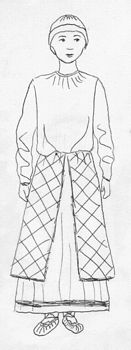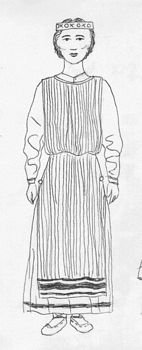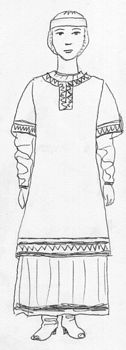
This married woman is wearing a panova over her rubakha.
This unmarried maiden is wearing a belted and pinned zapona over a rubakha.
This woman is wearing a navershnik over her rubakha.
This woman is wearing a reconstruction of the Toroptse/ Izyaslavl dress.
The Panova (aka poneva, ponova, ponyava, plakhta, yubka...):
-
In the main, for ancient Russian women the rubakha was supplement by a
"loin" garment - the "ponyavoj" or "ponyovoj". This term is often met in
copies of church anthologies of the most early times. V. I. Dal' presumed
that the word "ponyova" came from the verb "ponyat, obnyat;'" (to understand,
to embrace), since the ponyova was presented as a piece of fabric which
wrapped around the body. There is no direct evidence this was just "loin"
clothing, although, for example, on a bracelet found in Old Ryazan, a female
dancer is portrayed in a ponyova and apron with the undulating pattern of the
fabric or embroidery of the ponyova repeated on the sleeves. M. G.
Rabinovich believes that the ponyova up until the 16th cent. was simply
called "linen fabric or shirt". However mention of the ponyova in the
statute of Prince Yaroslav (12th cent.) as a garment different from "belyx
port" and "polotna", allows one to propose that the term referred to a
garment worn apart from the rubakha. (Pushkareva89)
Loin clothing. [Набедренная одежда]. For women the rubakha was supplemented by "loin" clothing - unsewn pieces of checked half-wool fabric, which were worn kept up with ties around the waist, with the edge in front coming apart a little, leaving uncovered the hem of the shirt. What this garment was called in ancient Rus is not known. Researchers think that the name “ponyova” [понева] was not used for it earlier than the 16th century. Before that, as already said, ponyovoj or ponyavoj were names for linen fabric or the lower thin shirt, although could have existed under this name also wool or half-wool fabric (Rorre, 1965, p. 31). Archaeological finds of the eleventh to thirteenth century allow to present that colored checked ponyovy (as we will tentatively call them) were unique for different ethnic groups (Levinson-Nechaeva, 1971, p. 357–361). (Rabinovich, 9-13th c.)
In the 13-17th cent., a "hip/thigh/loin" garment [набеддренная одежда] supplemented the sorochka, and was worn at home and even outside in warm weather. In the 14th cent. this was evidently the same poneva that was worn in the earlier period. But after this time, the wear of the poneva gradually went out of fashion. It was replaced by another women's indoor garment, which began to spread in the middle or end of the 14th century - the sarafan. (Rabinovich, 13-17th cent.)
The panova was usually worn by married women over the rubakha. This "wrap-around" skirt was adopted from the steppe nomads and was usually made from three equal panels of fabric sewn together only at the top and gathered on a drawstring (gashnika). The panova was usually shorter than the rubakha, reaching to around the calves. (Kireyeva) and (Pushkareva97) and (Stamerov)
Ponyovy could be cloth [сукконные] or wool - from "volni", i.e. wool yarn. Archeological excavations of burials allow one to make the the conclusion that, in the 12-13th centuries, multicolored checked wool fabric "pestryad" already was known. "Pestryad" was used as the material for ponyovas of rural village women, since in the cities in the 14-15th centuries, the ponyova was worn more and more rarely. (Pushkareva89)
Panovas were made of linen or wool. They could be a single color or, often, multicolored, even of prints with a checked pattern or a rhomboidal lattice. In the 10-13th cent. this garment could be linen and the same color as the rubakha itself. Urban women stopped wearing them by the 14th century, but peasant women continued to wear them for several more centuries. (Pushkareva97 and 89) and (Stamerov) and (Kireyeva)
The information in Kolchin seems to indicate that the poneva was predominantly a rural garment even before the 14th century. Kolchin uses fabric fragments from Besedy in the Moscow region, Bityagova, and the Vyatichi kurgans to reconstruct 3 different ponevi. (Kolchin)
Over the poneva at the waist could be tied a woolen knitted [naalbinding?] belt, analogous to one found near excavations in the village of Gorki. (Pushkareva89)
Go to Miscellaneous SIG Garb Notes to read about the Great Poneva Debate.
-
Another outer garment, usually worn by maidens over the rubakha, was even
more ancient than the panova. It was the zanaviska or zapona, actually a
linen naramnik (?) which was a long rectangular length of fabric folded in
half at the shoulders and with a round neck-opening. It was not sewn
together on the sides, but pinned on both sides below the waist or just tied
up by its narrow belt. The zapona was always belted and,like the panova,
was shorter than the rubakha. (Stamerov) and (Kireyeva)
This garment is not discussed by Kolchin (or Pushkareva?).
-
The navershnik was even older than the zanaviska. It was a short tunic
that reached the calves and had short broad sleeves. [Stamerov does not
show the navershnik being worn over anything other than the rubakha nor does
he insist that it is a holiday garment. Kireyeva expresses a different
opinion. See below.] (Stamerov)
On holidays, the long tunic-like navershnik was worn over the zapona or the panova. It was made of fine fabric and ornamented with embroidery. It was cut rather wide with short wide sleeves. Worn unbelted, it created a static monumental form. (Kireyeva)
The navershnik resembles a longer version of the dalmatika. (See Layer 3.)
This garment is probably called a "jacket" by Pushkareva and resembles the Toroptsa/Izyaslavl dress of Kolchin depending on whether the sleeves should be short or long. Otherwise, Pushkareva and Kolchin do not discuss this garment. See below.
Jackets
-
Under coats or cloaks, women wore jackets of different types, short and wide
to the waist or long in front with narrow wrist-length sleeves. These were
often meant to be unfastened and were decorated with valuable buttons or fur.
[Pushkareva doesn't have illustrations of these, and I'm not quite sure what
she means by them. But see the dress below]. (Pushkareva97)
-
An entire dress was discovered in 1957 in the strata of Toroptsa, burnt in the second-half 13 cent. as a result of Lithuanian invasion. In the 30 years which elapsed from the moment of excavation, it was strongly deformed, since it was not restored. The dress was made up from the large number of large fragments. It was sewn from woolen fabric of various textures [?]. Top of dress - from the woolen cloths of tabby weave, the bottom - from the cloth of twill weave. The folds are visible on some fragments. Well was preserved the sleeve narrowing to the wrist with a gusset [lastovitsa, the underarm gusset]. It is made from the cloth of twill weave, the lastovitsa - from cloth of tabby weave. The seams, the connecting parts of dress, are made in such a way that the edges of the cloth would not be peeled off - with a "zaposhivochnym seam" [flat-felled]. This technique of sewing arose with the simulation of the cut of clothing. However, in Toroptse is found a piece of cloth with ornament in the "branoy" [brocade?] technique.
One additional entire dress is found in Izyaslavl. It was sewn from several forms of the finest woolen cloth of tabby weave and cut with a top/bodice and separate skirt. The top of the dress is lined. The collar [vorot] is sheathed with a kajma [border] of more closely woven cloth. The kajma is constructed double and is pierced with horizontal stitches. The neck slit, located on the left of the collar, passes into the shoulder seam. At the waist a skirt is sewn to the bodice. It is put together with small gathers, for which are sewn four parallel seams. At the seam uniting the bodice with the skirt, is sewn the golden-fabric ribbon, edged on two sides with silk thread, twisted in the form of rope. A kajma was sewn along the hem. Judging by the seams, the sleeve was sewn under the arm, where a strip of cloth with a width of 5 cm was sewn. This detail is sewn across the sleeve with the finest seam - "forward needle" [vpered igloj], and then a back stroke [backstitched?], the space between the stitches is filled so precisely, that it creates the impression of a machine seam. [The depiction of this seam looks like it was made with two passes of running stitch, placed to "leap-frog" each other, and thus, it resembles machine sewing.]
To judge the length of a dress is difficult. Only scientific restoration can give a complete idea not only about the technology of an article, but also about its form and size. If the proportions of the assembled dress are essentially correct, then its length reaches the knees.
[I'm not sure what these dresses are. If they are women's garments, as implied by Kolchin's illustrations - they could be jackets, navershniks or svitas. If they are men's garments, then they would probably be svitas. Pity the artifacts that archeologists dig up don't come with nice labels...]
Comments and suggestions to lkies@jumpgate.net.
Back to Women's Clothing or Early Rus Clothing.
Back to Russian Material



